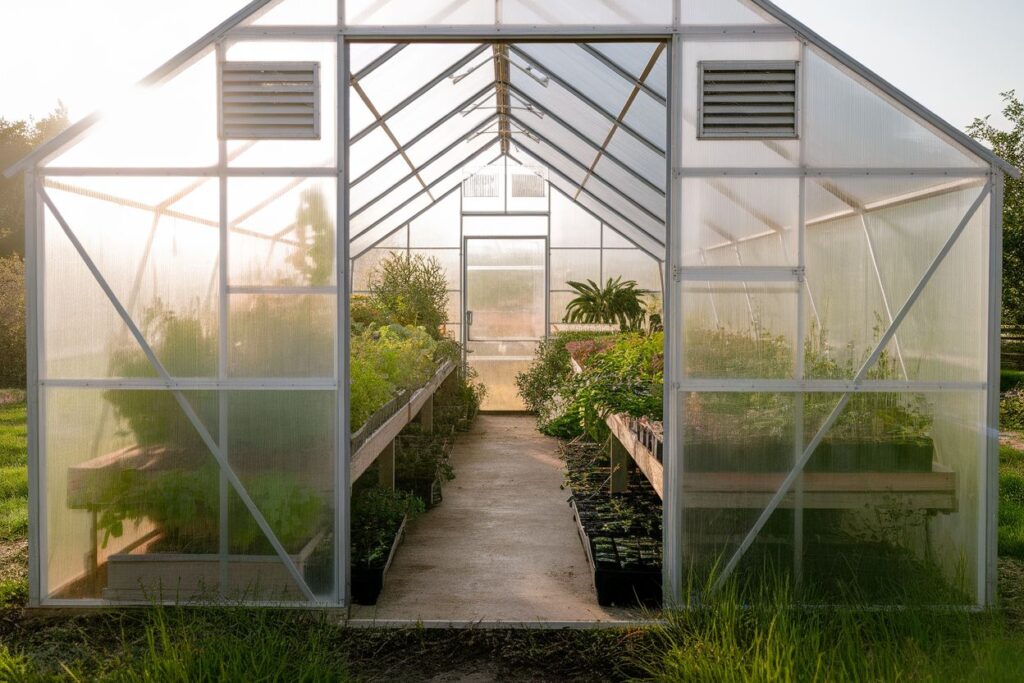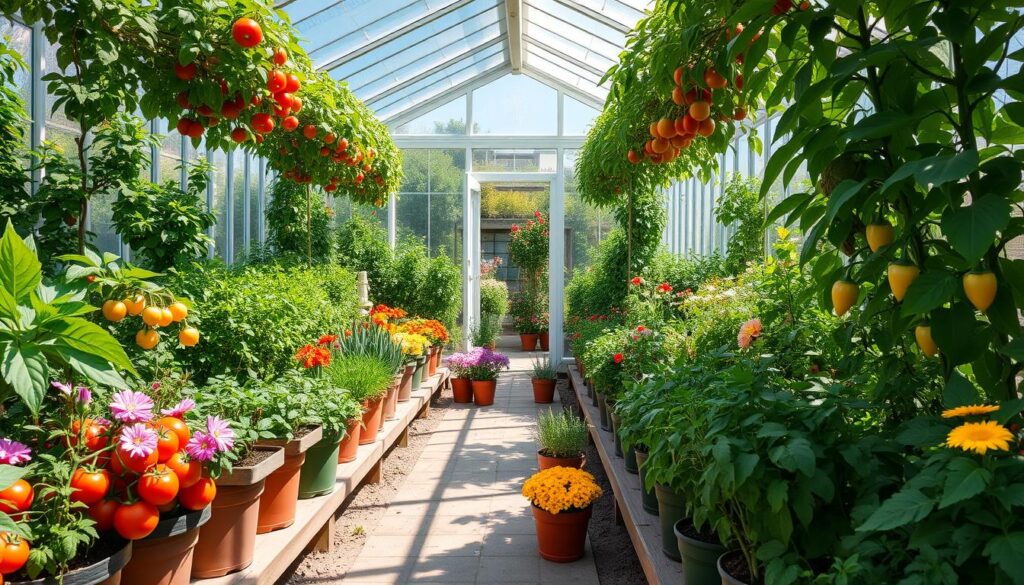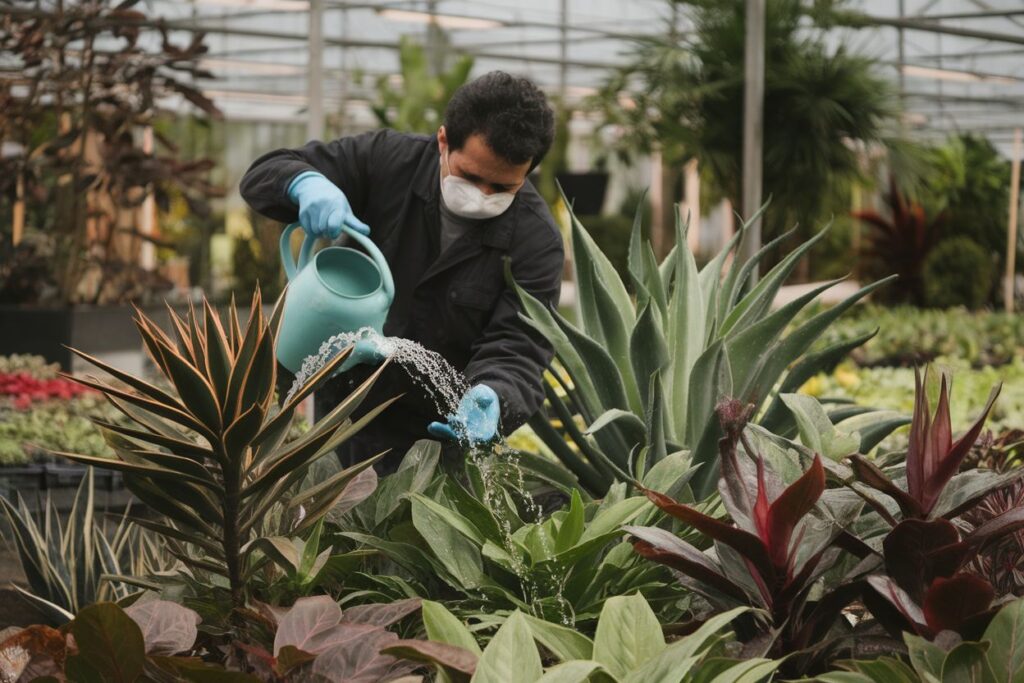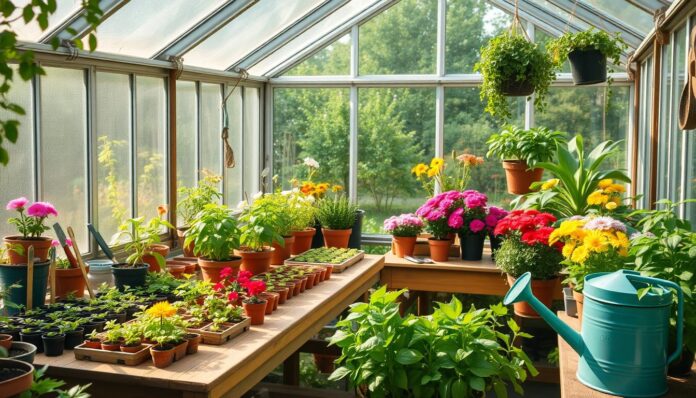Greenhouse gardening for beginners is a thrilling journey for plant lovers. It lets you grow plants all year round in a controlled space. This is perfect for beginners who want to care for plants with precision.
This guide will show you how to create your own greenhouse. It’s great for both new gardeners and those who want to improve their skills. You’ll learn about the basics of greenhouses and how to take care of your plants.
Greenhouse gardening solves many common gardening problems. It allows you to grow many plants, no matter the weather outside. Our guide will give you the tools and advice you need to start your greenhouse journey.
Understanding the Basics of Greenhouse Gardening
Greenhouse gardening is exciting for plant lovers and hobbyists. It lets gardeners grow plants all year, even in cold climates. This is because greenhouses create a warm, controlled space.
What is a Greenhouse?
A greenhouse is a special place for plants. It’s made to keep plants safe and warm. The walls are made of glass or plastic, letting sunlight in.
This sunlight heats up the inside, making it perfect for plants. Greenhouses protect plants from bad weather and keep the temperature steady.
Benefits of Growing Plants in a Greenhouse
Greenhouses offer many advantages. They keep plants safe from extreme weather and pests. They also keep the temperature and humidity just right.
Gardeners can grow plants that need warm weather in cold places. They can start seeds early and have longer harvests.
How Greenhouses Work
Greenhouses work by using sunlight. Sunlight comes in through the walls and warms the inside. This heat stays inside, making it warm for plants.
Systems that let air in and out help control the temperature. This makes sure plants grow well all year.
Choosing the Right Type of Greenhouse for Your Needs

Choosing the right greenhouse can change your gardening game. Different greenhouses offer special benefits for all gardeners. Knowing your options helps you pick the best one for your space, budget, and goals.
“The right greenhouse is like a personal garden sanctuary that extends your growing season and protects your plants.”
Freestanding greenhouses offer the most flexibility. They are great for those with lots of outdoor space. You can find them in sizes from small to very large, perfect for serious gardeners.
Lean-to greenhouses are perfect for beginners with little space. They attach to a house or garage, making the most of small areas. They also save on initial costs because they use the building’s heat.
For those with tiny spaces, mini greenhouses or portable ones are ideal. They fit on balconies, patios, or small yards. Made of lightweight materials, they are easy to set up, making them a great starting point.
When picking a greenhouse, think about sunlight, wind, and your local weather. Your greenhouse should fit your garden’s needs and help you grow your plants well.
Essential Equipment and Tools for Greenhouse Success
Greenhouse gardening needs careful planning and the right tools. Quality equipment helps plants grow well. It’s all about making your garden thrive.
Managing a greenhouse well means knowing the right tech and tools. These include temperature control and irrigation. Each part is key to a healthy indoor garden.
Temperature Control Systems
Keeping temperatures steady is crucial. Digital thermostats and heating/cooling systems help. Tools like electric heaters and fans keep plants at the right temperature.
Ventilation Requirements
Good ventilation stops heat buildup and disease. Roof vents, side windows, and fans help. They keep humidity and temperature balanced for plants.
Irrigation Solutions
Modern irrigation makes watering easy. Drip systems, misting, and timers give plants the right moisture. These tools save water and keep plants hydrated.
Basic Gardening Tools
“The right tools transform gardening from a chore to a pleasure.” – Professional Greenhouse Gardener
Important tools include pruning shears and soil thermometers. Also, potting trays, watering cans, and gloves are essential. Each tool helps keep plants healthy and growing.
Selecting the Perfect Location for Your Greenhouse

Choosing the right spot for your greenhouse is key to growing plants well. The location you pick can greatly affect your gardening success. Sunlight is a big factor in finding the best place for your greenhouse.
Look for areas that get lots of sunlight. Aim for spots that get 6-8 hours of direct sunlight each day. The south or southeast sides usually get the most sunlight, which is great for most plants.
Also, think about protecting your greenhouse from strong winds and bad weather. A spot near a fence or building can help block wind. Being close to water and electricity makes upkeep easier and setup simpler.
The ground level is important too. Pick a flat area that drains well to avoid water buildup. Stay away from low spots that might get frost or collect water. The ground should also be strong enough to hold your greenhouse.
Make sure the location is easy to get to from your house. It should have enough room for moving things and plants. A place that’s easy to get to helps you take better care of your greenhouse garden.
Setting Up Your First Greenhouse Garden
Turning your gardening dreams into reality starts with a good greenhouse setup. A well-planned greenhouse is key to growing your plants well. It’s a great way for gardeners of all levels to grow amazing plants.
Preparing a Solid Foundation
Your greenhouse journey begins with a strong base. Pick a level spot with good drainage and solid ground. Options include concrete slabs, gravel beds, or treated wood.
Make sure it gets enough sunlight and is safe from strong winds.
Step-by-Step Assembly Guidelines
Assembling your greenhouse needs patience and focus. First, read the instructions carefully. Then, get all your tools ready, like a measuring tape, level, drill, and safety gear.
Double-check that everything fits right before you install it for good.
“A well-planned greenhouse is the cornerstone of successful garden cultivation.” – Professional Gardening Expert
Interior Organization Strategies
Good organization in your greenhouse makes the most of your space. Use shelving, hanging baskets, and vertical systems to save room. Think about modular storage that can grow with your garden.
Good organization helps you manage your plants well. It makes your greenhouse a productive place to grow.
Best Plants for Greenhouse Gardening Beginners
Starting your greenhouse garden can feel overwhelming. But, choosing the right plants makes it exciting and rewarding. Easy greenhouse crops give new gardeners a boost of confidence.
Tomatoes are a favorite among greenhouse gardeners. They thrive in controlled environments and produce lots of fruit. Cherry tomatoes are great for beginners because they need little care and give big results.
Herbs are another great choice for beginners. Basil, mint, and parsley grow fast and do well in greenhouses. They’re perfect for small spaces and give you fresh flavors right away.
Leafy greens like lettuce and spinach are perfect for beginners. They grow fast, like cooler temperatures, and can be picked many times. They’re healthy, use little space, and give quick results.
Peppers and cucumbers are also great for beginners. They do well in greenhouses and give consistent results with the right care. Beginners can try different types and learn as they go.
Creating the Optimal Growing Environment
Greenhouse gardening is all about creating the perfect spot for plants to grow. It’s all about controlling the climate. This means managing temperature, humidity, and light to make your greenhouse a great place for plants to thrive.
Creating the best environment for plants is a big job. It involves many factors. Plants need careful attention to grow well, making climate control very important.
Temperature Management
Keeping the temperature right is key for plant health. Most plants do best in temperatures between 60-75°F. Using digital thermostats and systems that heat and cool can help keep the temperature steady.
Thermal screens and shade cloths also help control the temperature. They are useful tools for gardeners.
“Control the temperature, control the growth” – Professional Greenhouse Gardeners Association
Humidity Control
Plants need different levels of humidity to grow well. Some plants like it wetter, while others prefer it drier. Using humidity trays, misting systems, and good air flow helps keep the humidity right.
It’s important to watch the humidity to prevent diseases. This helps plants grow strong and healthy.
Light Requirements
Light is essential for plant growth. Grow lights can help plants get enough light, even when it’s dark. Using reflective surfaces and placing plants in the right spot can also help use natural light better.
Knowing what light each plant needs is important. This ensures your greenhouse is the best place for them to grow.
Soil and Growing Medium Essentials
Choosing the right greenhouse soil is key for growing plants well. Different growing mediums bring unique benefits. They help gardeners create the best conditions for their plants. Knowing about different potting mix options can greatly improve your greenhouse gardening.
Greenhouse soil is not just regular dirt. Experts suggest using special potting mix for good drainage, nutrient holding, and root support. Organic compost, peat moss, and vermiculite are often used. They make a great growing space for plants.
Think about what your plants need when picking growing mediums. Succulents do well in sandy, draining mixes. Vegetable gardens need rich, nutrient-packed mixes. Perlite helps with soil aeration and prevents it from getting too dense. This helps roots grow strong.
Important things to look at in greenhouse soil are:
– Nutrient content
– Drainage
– pH balance
– Organic matter percentage
Many greenhouse gardeners mix different materials to make their own growing mediums. Trying out different mixes can help you find the best soil for your plants.
Watering and Feeding Schedule for Greenhouse Plants

Mastering plant nutrition and water management is key to successful greenhouse gardening. An effective watering and feeding plan boosts plant health and productivity. This is especially true in controlled environments.
Watering in greenhouses needs careful attention to each plant’s needs. Different plants require specific moisture and nutrients to grow well. Knowing these needs helps avoid overwatering or nutrient shortages.
Irrigation Methods
Today’s greenhouse watering includes drip irrigation, micro-sprinklers, and automated systems. Drip irrigation delivers water directly to the roots, saving water and ensuring plants get the right amount of moisture. These methods help conserve water while promoting healthy plant growth.
Fertilization Guidelines
Fertilizing plants in greenhouses requires a thoughtful plan. Using slow-release fertilizers and balanced nutrients supports steady growth. Regularly checking soil nutrient levels helps gardeners fine-tune fertilization for better plant health.
Water Conservation Tips
Conserving water is vital in greenhouses. Collecting rainwater, using efficient irrigation, and monitoring water use can cut down on water use. Recycling water and using mediums that retain moisture also support sustainable gardening.
Common Greenhouse Gardening Challenges and Solutions
Greenhouse gardening comes with its own set of challenges. It’s important to know what these are to keep your plants healthy. Keeping pests and diseases away is key to protecting your plants.
Pests like spider mites, aphids, and whiteflies are big threats. They can quickly spread in a greenhouse. Regular checks help spot problems early. Using beneficial insects, like ladybugs, can help control pests naturally.
To prevent diseases, you need a plan. Good air flow, the right humidity, and enough space between plants help. Clean tools and potting materials also stop diseases from spreading.
Keeping an eye on the environment is crucial. Changes in temperature, water, or nutrients can harm plants. Using digital tools helps you stay on top of these issues.
Choosing sustainable solutions like integrated pest management is better than harsh chemicals. Understanding your greenhouse helps you create a healthy space for your plants.
Seasonal Maintenance and Care Tips
Year-round gardening needs careful greenhouse maintenance with the seasons. Each season has its own challenges that need attention. To keep your plants healthy, adjust your care plan for each season.
In winter, your greenhouse needs extra care to avoid cold damage. Use bubble wrap for insulation, add heating systems, and cover plants from frost. Also, check seals and windows to keep warmth in. Water plants less and use frost cloths on tender ones.
Summer care is about keeping it cool and well-ventilated. Add shade cloths, use vents, and ensure air flows well. Watch the temperature, as greenhouses can get too hot. Fans or evaporative coolers can help control the heat.
Spring and autumn need special care too. Clean and disinfect, check the structure, and get ready for new plants. Look for pests, replace old gear, and refresh soil for healthy plants.
Regular upkeep stops damage and keeps your greenhouse productive all year. Make a seasonal checklist for repairs, cleanings, and plant care.
Final Thoughts
Greenhouse gardening for beginners is a fun way to grow fresh food and plants all year. As a beginner, you’ve picked up key tips for a successful indoor garden. These skills will help you turn a simple greenhouse into a lively plant world.
Indoor gardening is more than just growing plants. You’ll learn to control temperatures, understand soil needs, and care for your plants well. Each time you harvest or see a plant bloom, it’s a victory. It shows the power of growing plants indoors.
Greenhouse gardening is a journey that never ends. Each season brings new things to learn and do. Start small, be patient, and enjoy the learning process. Your greenhouse will become a place of green innovation and growth.
With hard work and the knowledge you’ve gained, your greenhouse gardening journey will grow. Keep exploring, stay curious, and watch your garden become a place of abundance and joy.











